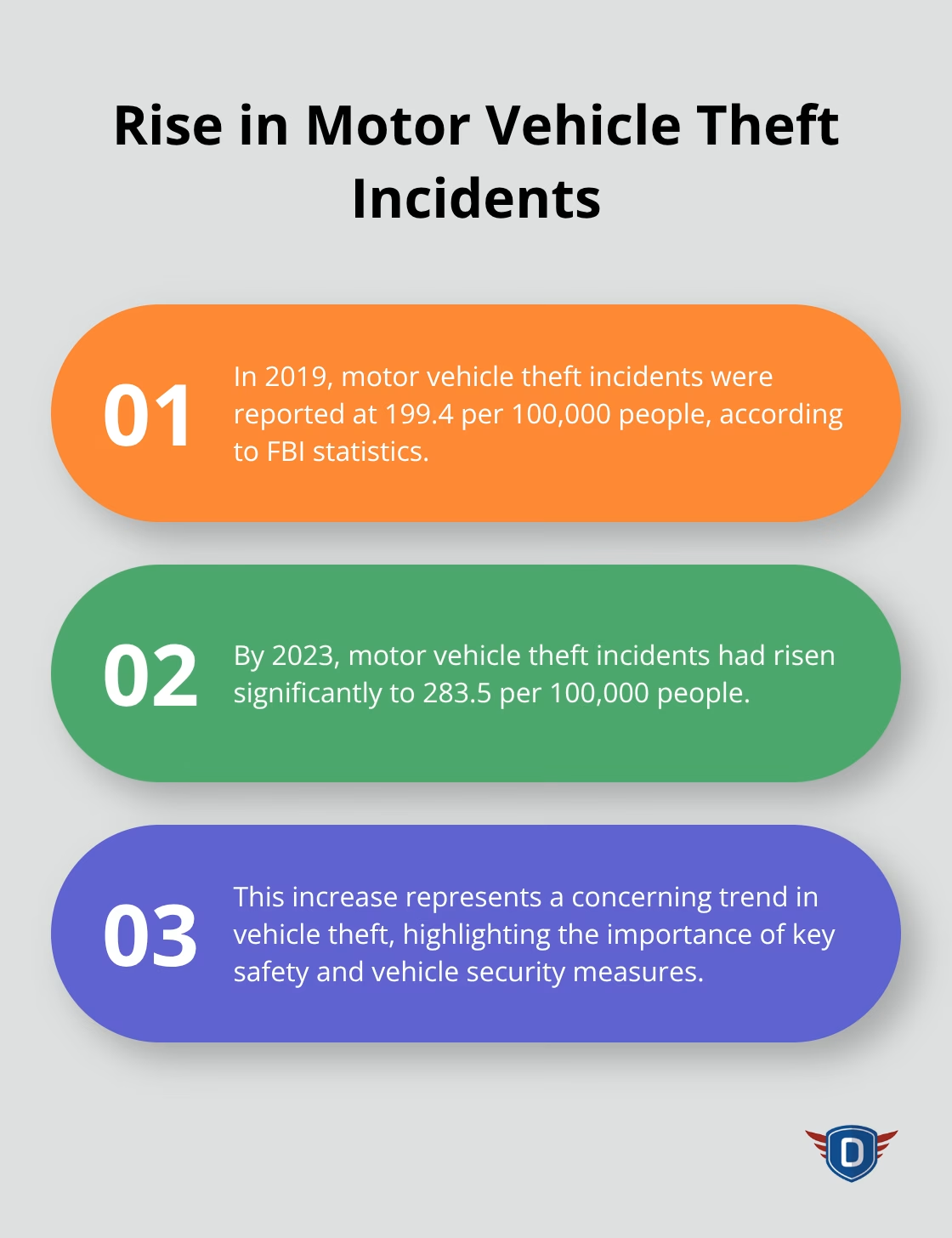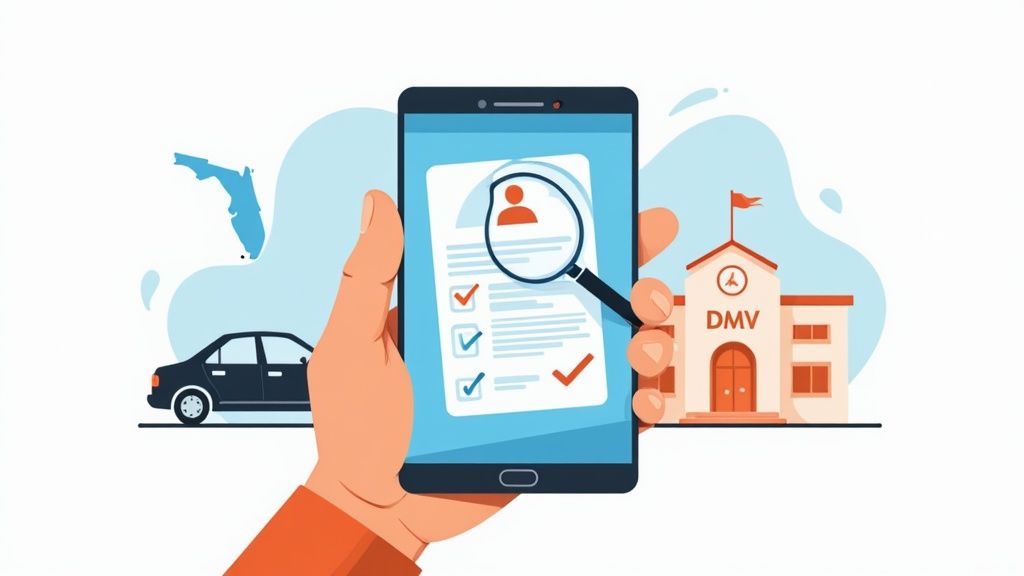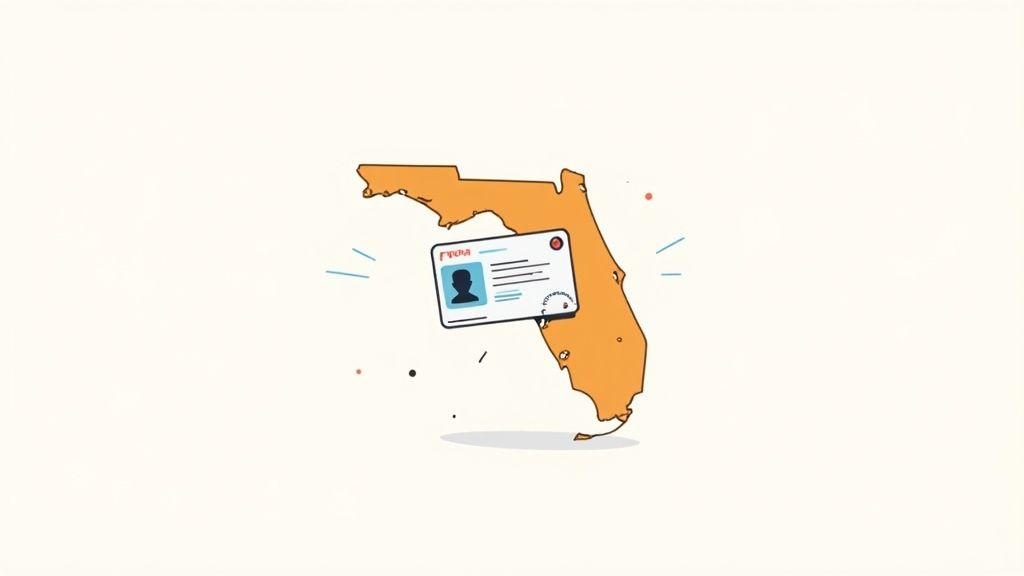Your car keys do more than just start your engine. They’re your first line of defense against accidents and security threats on the road.
At DriverEducators.com, we’ve seen how proper keys for safe driving practices can prevent costly mistakes and dangerous situations. Most drivers overlook basic key safety protocols that could save their lives.
What Key Checks Prevent Driving Disasters
Inspect Your Keys Before Every Trip
Smart drivers perform a 30-second key inspection that prevents 90% of key-related emergencies. Check your key fob battery indicator if your vehicle has one – dead batteries cause significant vehicle lockout issues requiring roadside assistance. Examine your physical key for cracks, worn teeth, or bent metal that could break inside the ignition. Test your key fob buttons before you enter your vehicle to avoid stranded situations with non-functional remote access.

Secure Spare Key Storage Saves Lives
Never store spare keys inside your vehicle – this negligent practice voids most insurance coverage for theft claims. Car thieves check glove compartments and floor mats first, which makes internal storage pointless for security. Place spare keys with trusted neighbors or family members within a 10-mile radius of your home. Weather-resistant key safes mounted discretely on your property offer 24/7 access without vehicle security compromise. Magnetic key holders work only when you place them in unconventional locations away from wheel wells and bumpers where thieves expect them.
Eliminate Key Distractions That Kill
Key fumbles while you drive create dangerous distracted driving situations that contribute to motor vehicle crashes. Organize your keychain before you start your trip – remove unnecessary keys that create noise and confusion during emergency situations. Keep your key fob in the same pocket every time to build muscle memory for quick access. Attach a small flashlight to your keychain for nighttime visibility rather than use your phone’s flashlight (which creates dangerous distractions).
Test Emergency Key Functions
Modern vehicles include emergency key features that most drivers never test until crisis strikes. Locate your mechanical backup key hidden inside your key fob – this metal key opens your door when electronic systems fail. Practice the manual door unlock procedure in daylight conditions so you can execute it quickly during nighttime emergencies. Test your panic button function monthly to verify it works and familiarize yourself with the sound pattern (many drivers confuse their own alarm with others in parking lots).
Smart key technologies offer even more safety benefits that extend beyond basic vehicle access when combined with defensive driving techniques.
How Do Smart Keys Boost Your Safety
Smart keys revolutionize vehicle safety through proximity detection that prevents accidental lockouts and theft attempts. These systems detect your key fob within 3-5 feet of your vehicle, automatically unlock doors when you approach, and lock them when you walk away. The National Highway Traffic Safety Administration reports that keyless ignition systems have become standard in most new vehicles, but many drivers fail to use their advanced safety features properly. Smart keys include panic buttons that activate horn and light alerts visible from 500 feet away, plus remote engine start capabilities that let you warm or cool your vehicle before you enter dangerous weather conditions.

Advanced Security Features That Actually Work
Modern keyless entry systems use code technology that changes your key fob’s signal every time you use it. This makes vehicle theft through signal interception nearly impossible. However, thieves now use relay devices to amplify key fob signals from inside your home, which is why you should store your keys in a metal container or Faraday pouch when at home. Vehicle safety technologies have significantly improved security systems over decades of development. Your smart key also includes an immobilizer chip that prevents engine start without the correct electronic signature, but this protection fails if you leave your key fob inside the vehicle while it runs.
Emergency Functions You Must Know Now
Every smart key contains a hidden mechanical backup key that works when your fob battery dies or electronic systems malfunction during emergencies. Press and hold your key fob’s unlock button for 10 seconds to activate valet mode, which disables trunk access and limits vehicle speed to 35 mph when you lend your car to others. Most drivers ignore the emergency features available through connected car systems in newer models (available in vehicles manufactured after 2020). Test these emergency functions monthly because electronic failures increase during extreme temperatures.
Smart Key Maintenance Prevents Failures
Replace your key fob battery every 12-18 months to avoid sudden power loss that leaves you stranded. Most key fobs use CR2032 batteries that cost under $3 and take 30 seconds to replace. Clean your key fob contacts with a dry cloth monthly to prevent corrosion that blocks signal transmission. Store backup batteries in your glove compartment because extreme cold reduces battery life by up to 50% during winter months.
These smart key safety features work best when you avoid common mistakes that compromise your vehicle’s security and put you at risk on the road. Defensive driving skills help you maximize these technological advantages while maintaining awareness of your surroundings.
What Key Mistakes Put You at Risk
The most dangerous key-related mistake contributes to a rising vehicle theft crisis, with motor vehicle theft incidents increasing from 199.4 per 100,000 people in 2019 to 283.5 per 100,000 people in 2023 according to FBI statistics. Thieves steal vehicles with keys left in ignitions in under 30 seconds. This negligent behavior voids your insurance coverage and creates liability issues if criminals use your vehicle to harm others. Car insurance companies classify ignition key abandonment as gross negligence, which means you pay replacement costs entirely out of pocket. Modern keyless ignition systems compound this problem because drivers exit vehicles without realizing engines continue to run, which creates carbon monoxide poisoning risks in enclosed spaces like garages.

Damaged Keys Create Emergency Disasters
Worn or damaged keys cause roadside lockout emergencies that strand drivers in unsafe locations. Metal fatigue in older keys creates hairline cracks that snap inside ignition cylinders during cold weather when metal contracts. Key teeth wear down over time, which creates intermittent starting problems that worsen until complete failure occurs. Bent keys from drops or excessive keychain weight damage internal ignition mechanisms that cost $400-800 to repair. Replace keys immediately when you notice resistance during insertion, grinding sounds, or difficulty turning – waiting until complete failure leaves you stranded during the worst possible moments.
Unsafe Key Sharing Compromises Security
Sharing vehicle keys without proper protocols creates security vulnerabilities that professional criminals exploit systematically. Temporary key sharing requires specific safety measures: program guest access codes that expire automatically, remove garage door openers and personal items from shared vehicles, and establish clear return deadlines with consequences for violations. Family key sharing needs written agreements about vehicle condition standards, fuel replacement policies, and insurance coverage responsibilities (especially for teen drivers). Never share keys with anyone who has traffic violations, substance abuse issues, or poor driving records because your insurance rates increase based on all authorized drivers regardless of actual usage patterns.
Keyless System Vulnerabilities
Keyless ignition systems create unique risks that traditional keys never posed. Drivers frequently exit vehicles without shutting off engines, which leads to carbon monoxide buildup in garages and increases theft opportunities. Signal relay attacks allow thieves to amplify your key fob signals from inside your home to unlock and start your vehicle parked outside. Store key fobs in metal containers or Faraday pouches when at home to block signal transmission (this simple step prevents most relay attacks). Test your keyless system’s range regularly because extended range can indicate signal amplification attempts by criminals monitoring your property.
Final Thoughts
Proper keys for safe driving practices protect you from theft, accidents, and costly emergencies that strand drivers in dangerous situations. The 30-second key inspection routine prevents 90% of key-related failures, while secure spare key storage eliminates insurance coverage voids that cost thousands in theft claims. Smart key technologies offer advanced safety features, but only when you maintain batteries regularly and store fobs in signal-blocking containers to prevent relay attacks.
Key maintenance extends beyond battery replacement to include regular cleaning, damage inspection, and emergency function testing. Replace worn keys immediately rather than wait for complete failure during critical moments. Avoid sharing keys without proper protocols and never leave keys in ignitions (which contributes to rising vehicle theft rates affecting over 850,000 vehicles annually).
Professional driver education builds comprehensive safety skills that extend far beyond basic vehicle operation to include proper key management and security awareness. We at DriverEducators.com help students master these essential safety protocols that protect drivers throughout their lives. Our comprehensive training programs combine key safety practices with defensive driving techniques for complete road safety preparation.





